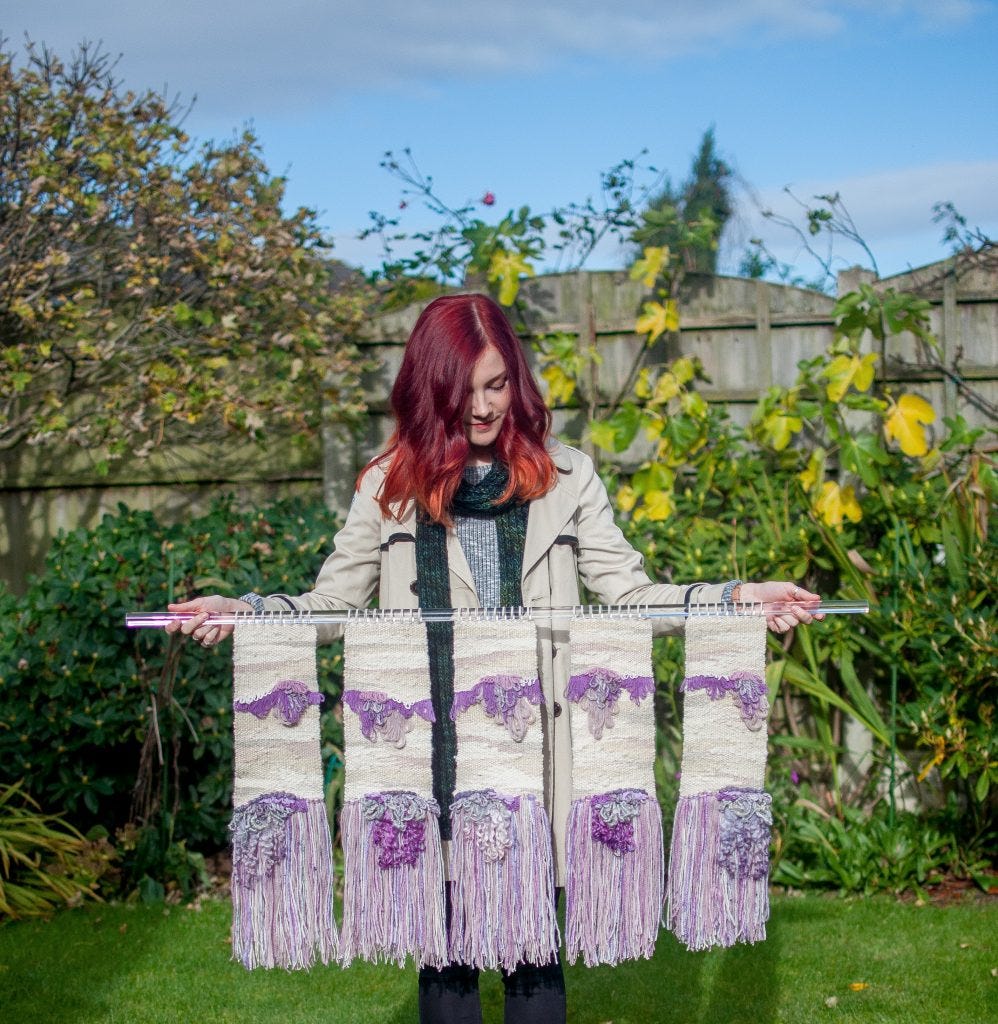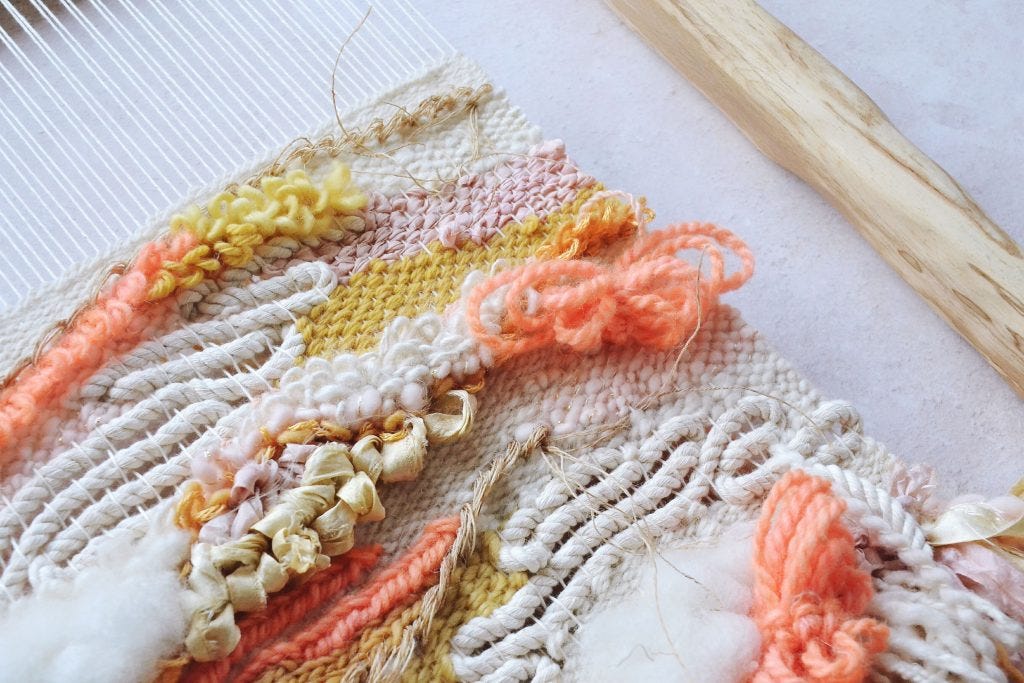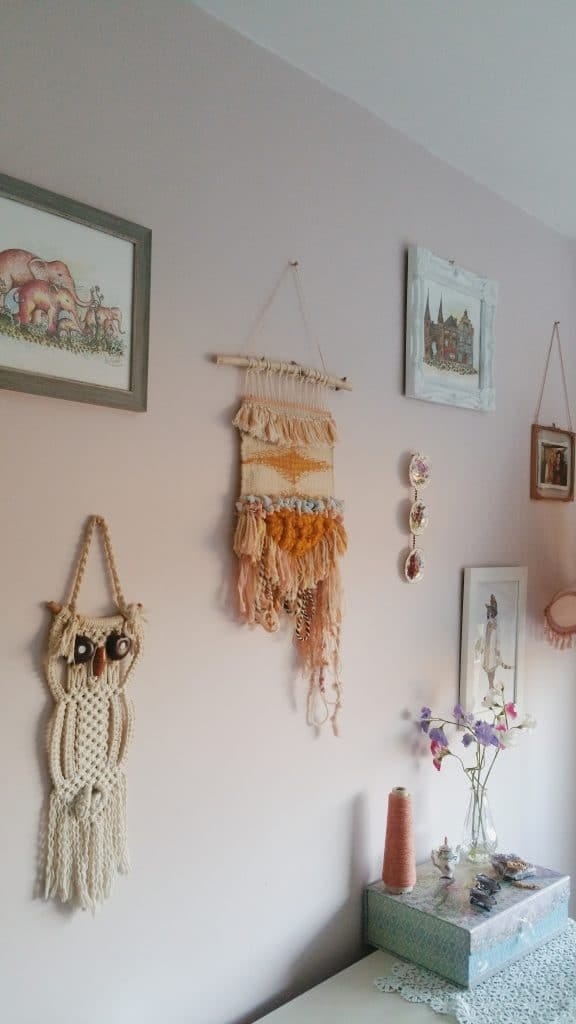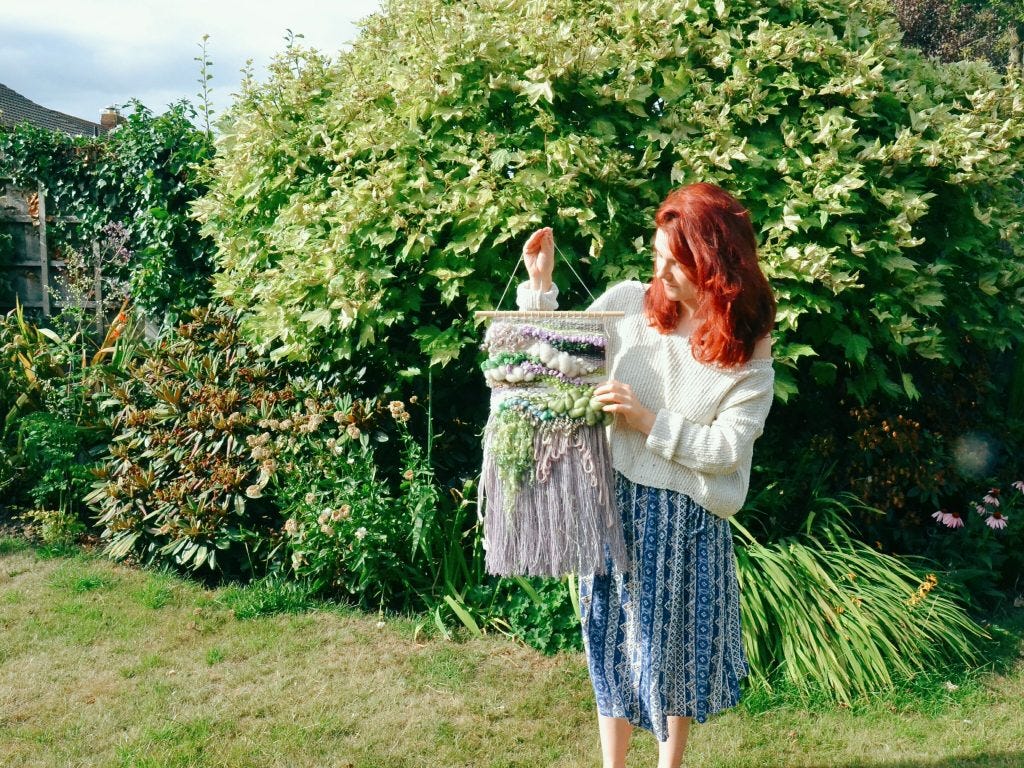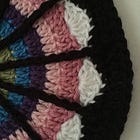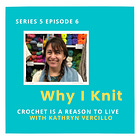Sophie of Wallflower Weavings Shares The Mental Health Benefits of Weaving
"When you get into a rhythm, you don’t notice the hours passing and that your many thoughts are accompanying the growth of your design, your anxieties have been released into something beautiful."
This article originally appeared on the PsychCentral blog Crafting to Heal which I wrote in 2019. Since the blog has since been archived, I have some posts related to craft as therapy from that archive that I want to share here on Substack, including this interview with Sophie Cotterill of Wallflower Weavings.
Although I’m mostly a crocheter, I do some other fiber arts as well, including a little bit of frame loom weaving. Sophie’s rich texture, color choices, and the detail in her weavings always appealed to me; just looking at them sometimes felt a bit therapeutic. Therefore I was thrilled when I saw a post mentioning that she finds weaving to be healing. I asked if she would be willing to do an interview, and she generously shared her thoughts on the mental health benefits of weaving. She hasn’t posted recently on Instagram but her words here are timeless.
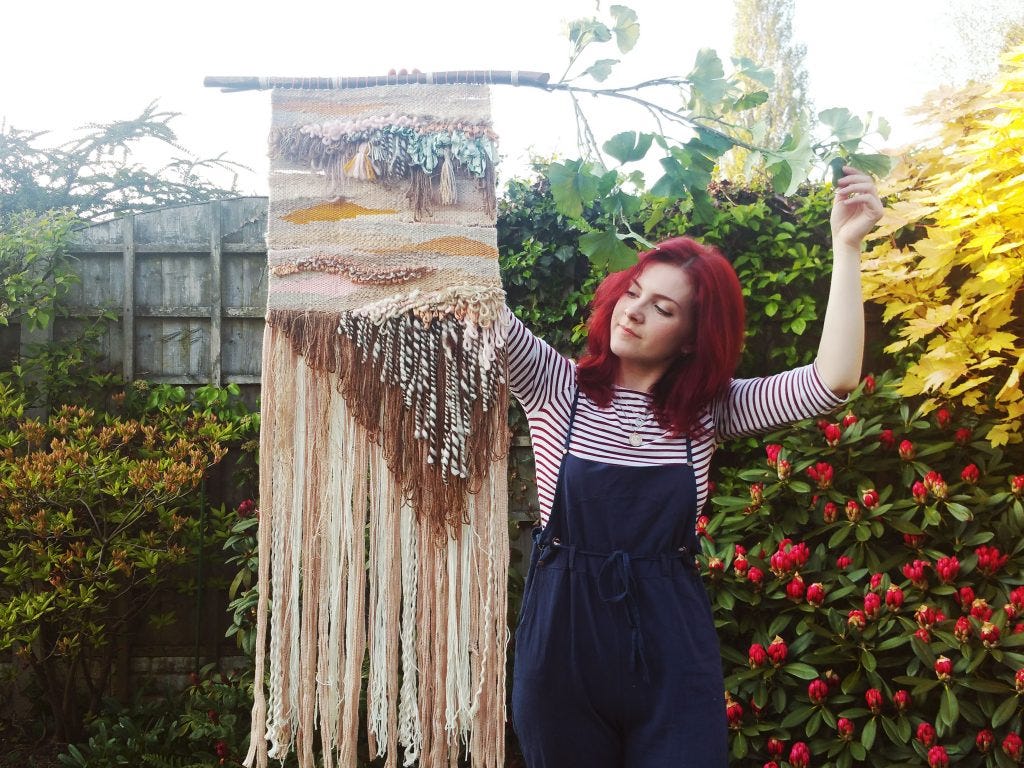
When and how did you learn to weave?
I learned to weave in 2014 during a year abroad in The Netherlands. It was an instant source of confidence and mental wellbeing.
Weaving came to me during a time where I was in limbo, finding it difficult to get work in my new, foreign town. My confidence and motivation were at such a low. I was experiencing a great deal of loneliness and worry, which turned into tiredness and struggling to carry out simple tasks like just leaving the apartment.
The moment I began to weave, it gave me a purpose. I was excited to go out and source materials and equipment on a budget. I was eager to dedicate my days to learning and improving my techniques. Within the space of a fortnight, my time in the apartment became something I looked forward to. I was soon spending the majority of my hours weaving.
Yet you were still alone in your apartment right?
Yes, but no. With weaving, came purpose, interest, and inspiration! This was only further enhanced when I decided to document what I was learning on Instagram alongside others. At this point, there wasn’t a huge market or interest in modern weaving, but what was there was a goldmine.
Individuals from around the world were coming together to provide knowledge, inspiration, and encouragement about this newly-popular craft that had us absolutely hooked. I still speak to these makers to this day, nearly five years on. We have shared our work with each other, engaged in art and material swaps, and have helped each other get noticed.
So, though to an outsider I was sitting in that little rooftop apartment on my own, I was actually a part of a craft movement that was taking place across continents.
Then what happened?
Since returning home in the summer of 2015, I was able to expand my space and therefore my equipment and skills. My emotional investment in weaving was so strong. My confidence had increased so much, knowing that I really had something of my own making to work on and be proud of. My online shop had opened whilst abroad and had gotten off to a great start. I was massively motivated to keep things rolling and improving.
So, the confidence kept you going. What are some other mental health benefits of weaving? And how do you approach a therapeutic project?
The actual act of weaving, like many crafts, takes place alone in a cozy corner of the house. Most weavers I know, along with myself, like to have everything “just so” to begin the process. Having a clear desk and tidy studio to begin working in is like clearing the mind. You’re organized, your favorite music is playing, the candles are lit, and your materials are waiting to be made into something beautiful. From there, you can make a lovely mess of things! The cycle of preparation, creating, and cleaning down to start again is really refreshing.
Weaving itself is a process reliant upon patience and method. Your loom has to be prepared so that it is sturdy, your materials have to lend themselves properly to what you are making, and your technique has to be right for the piece to be strong and beautiful. However, what I like about weaving, which I didn’t personally find in other crafts I had tried in the past, is that for a mind like mine which likes to be freeform and unrestricted, weaving was filled with freedom to explore.
Once the loom is readily warped (the vertical threads) your weft (horizontal threads, where the design emerges) is determined uniquely by your two hands. You can go for geometric, follow patterns and count threads, or take an organic approach without a design in mind, which is what I do. I enjoy letting the design develop instinctively, not knowing what lies a few inches ahead, just taking it one section at a time. I love the freedom of this. It is like releasing your creativity and hectic thoughts out onto a canvas of fiber.
Alternatively, following patterns and taking time to count and be extra careful, to create something more controlled, also has its benefits. Recently I made a piece such as this for the sole intention of leveling an anxious mind. With a lot happening personally, it feels very calming to work in straight lines, as if you’re straightening out your thoughts. When you get into a rhythm, you don’t notice the hours passing and that your many thoughts are accompanying the growth of your design, therefore, your anxieties have been released into something beautiful.
It sounds like weaving has made a huge impact on your life.
It has changed things forever. I know that I will always have this craft by my side, and it is something just for me. When most of life is shared – with family, friends, and coworkers – I think it is very healthy to take time to do something alone and know that it empowers you.
It has also opened doors into learning further skills such as
hand spinning, a very rhythmic and controlled practice
hand dyeing, which is a slow process which encourages patience
plant dyeing, which has led to plans for a natural dye garden in my new home.
Finally having a space of my own means that my craft can surround and inspire me at all times. So, from harvesting plants and flowers to use in dyeing, to hanging the work of fellow artists on my own walls, and working amongst their inspirations, my daily life is forever changed and improved by the presence of weaving.
You have shared so many mental health benefits of weaving including improved confidence, productivity, creativity, mood-boosting, and mindfulness. What would you suggest who wants to reap these benefits but is brand new to weaving?
I would hugely encourage anyone to experiment with weaving, or indeed any craft. Certain crafts are great for calmness and control, while others will help with expression and emotional release.
An important change in my approach was to realize that not everything has to be perfect. In fact, every experiment is valuable. Simply the act of sitting down and doing something for yourself is more important than you may realize.
If you wanted to start up a new craft, the online community is so very encouraging and helpful. Nowadays you can find kits, lessons, and guides online that haven’t been available in the past, and those who curate them will happily answer questions and help you get started. You can buy materials and equipment direct from the people who make them, and who share the same crafts.
If you find enjoyment in it, persevere! You never know where your craft might take you, but undoubtedly it will have a positive impact on your wellbeing just to take the time out to focus in on something creative.
Other Interviews with Sophie:
Meet the Maker: Sophie Cotterill of Wallflower Weavings at 91 Magazine
“‘Where many of the weaving world’s pieces are classic, neutral and minimal, my work organically took a different direction over time into deeply tactile and colourful work. They’re very feminine pieces, quite delicate with intricate details – a real feast for the eyes, like a bouquet of yarn! That’s part of the reason for calling them “Wallflowers”,’ she says.”
Handmade Podcast: Anna Ploszajski talks to Sophie Cotterill
If you read this far, perhaps you liked the work. The work does take work. It only continues with support, so please consider subscribing. My annual rate starts at $10 per year.




